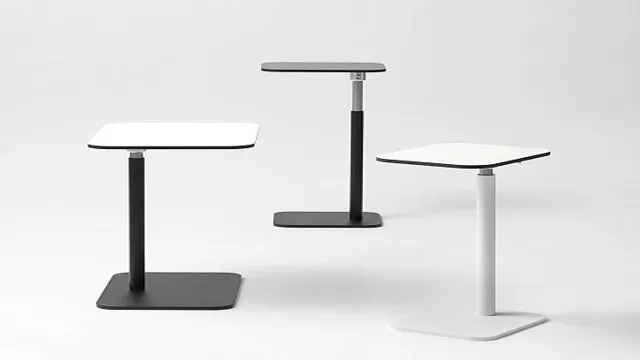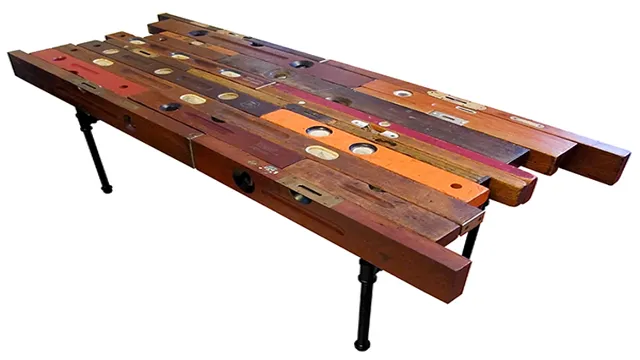Have you ever sat down at a table to enjoy a delicious meal, only to find yourself constantly adjusting your drink or plate so that it doesn’t tip over? Not only is it frustrating, but it can also be dangerous. Tables that are not level can pose a serious hazard to both people and objects. Thankfully, leveling a table is an easy fix that can be done in just a few steps.
In this blog post, we will discuss the most effective ways to level a table and ensure that your meals are always enjoyed safely and comfortably. So, grab a drink and let’s dive in!
Identify the Uneven Legs
If you’re trying to enjoy your meal, the last thing you want is to have your table wobbling, making everything topple over. To solve this problem, you need to identify which leg or legs aren’t making proper contact with the ground. Start by placing a level on top of the table to determine which direction the table is leaning.
Once identified, take a closer look at the legs. Look for any noticeable dents, cracks or signs of unevenness on the legs. You can also try rocking the table gently from side to side to see if any of the legs are loose.
Once you’ve figured out which leg is the culprit, try to adjust it by adding a shim underneath. A shim can be anything from small pieces of cardboard to wine corks. Slip it under the problematic leg until the table is level and steady.
Repeat this process as necessary until the table sits flat and steady on any surface. With this simple trick, you can enjoy your meal without any disturbance.
Check with a Spirit Level
One of the most frustrating things about setting up furniture is dealing with uneven legs. Not only does it make the furniture wobble, but it can also cause damage to floors. Luckily, one easy way to identify which legs are uneven is by using a spirit level.
Simply place the spirit level on one corner of the furniture and adjust the legs until the bubble is in the center. Then, move the spirit level to the opposite corner and repeat the process. If the bubble is still in the center, those two legs are even.
However, if the bubble is off-center, then those legs need to be adjusted accordingly. This process may take some trial and error, but it will ensure that your furniture is stable and secure. So, next time you’re struggling with wobbly furniture, grab a spirit level and identify the uneven legs.

Use Shims to Adjust
When it comes to uneven furniture legs, shims can be a great solution to adjust the height difference. However, before you start using shims, it’s essential to identify which legs are uneven. To do this, place a level on top of the furniture, near each leg.
If the level bubble isn’t centered, then that leg is uneven. Once you’ve identified the uneven legs, you can begin to adjust them. Place a shim under the leg until the furniture becomes level.
Shims come in various materials, such as wood or plastic, and in different thicknesses to help you make precise adjustments. Using shims can seem like a small fix, but it can prevent wobbling furniture and reduce the risk of accidents. So, the next time you notice uneven legs, consider using shims to adjust them and restore stability to your furniture.
Make Small Adjustments
When it comes to leveling a table, making small adjustments can go a long way. Start by checking the legs of the table to see if any of them are uneven. If so, try placing a small shim or piece of cardboard under the shorter leg to balance it out.
If this doesn’t work, you may need to adjust the screws that hold the leg in place. Use a level to ensure that the table is straight, adjusting the legs as needed until it sits evenly. Additionally, consider the surface that the table is sitting on.
If it’s an uneven or bumpy floor, placing a rug or mat underneath the table may help to keep it level. With a little bit of patience and some small adjustments, you can have a perfectly level table in no time!
Rotate the Table
Sometimes, all it takes is a small adjustment to give your space a fresh new look. One easy way to achieve this is by rotating your table. Simply turning your table 90 degrees or even just switching the positions of the chairs can have a big impact on the overall feel of the room.
Additionally, rotating your table can also help you make better use of the space you have available. For example, if your table is currently blocking the flow of the room, a simple rotation could open up the area and make it feel more inviting. So if you’re looking to refresh your space without investing in new furniture or decor, try rotating your table and see what a big difference it can make!
Add or Remove Shims
If you’re noticing that your door isn’t closing quite right, or that there’s a gap between the door and the frame, you might need to add or remove shims. Shims are small pieces of material that are used to level out surfaces before attaching them together. In the case of a door, shims can be added or removed to adjust the alignment and ensure a proper fit.
To add a shim, you’ll need to remove the screws from the hinge, place the shim behind the hinge, and then reattach the screws. To remove a shim, simply reverse the process. Make sure to only make small adjustments at a time to avoid overcorrecting, which can cause more problems.
With a little bit of patience and some trial and error, you can easily fine-tune the fit of your door with shims.
Use Furniture Levelers
Furniture levelers are an excellent solution for making small adjustments to your furniture. These nifty devices can be installed on the legs of your furniture and allow you to adjust the height by a small amount, making them perfect for when your floors are uneven or your furniture seems a little wobbly. With their adjustable design, furniture levelers can provide stability to your furniture, ensuring it stays in place and prevents falls or accidents.
They are incredibly easy to install, too, and can be adjusted with a simple turn of a screw. So, if you’re looking for a simple and effective solution to keep your furniture level and stable, furniture levelers are a perfect choice!
Test the Stability
So, you’ve just finished leveling your table and it looks perfect. But how do you know if it’s really stable? The last thing you want to happen is for the table to crash during dinner and ruin the ambiance. The best way to test the stability of your table is to give it a little shake.
You don’t have to shake it violently, just a subtle nudge will do. If the table wobbles or shakes, then you need to readjust the legs. You may also want to try placing some weight on the table to see if it tilts.
If it does, then you’ll need to make further adjustments to make sure it’s completely level. Remember, a stable table is not only important for aesthetics but also for safety reasons. By taking the time to test the stability of your table, you can ensure that your guests can enjoy their meal without any worries.
Check with a Spirit Level Again
Once you’ve installed your shelves, it’s important to test their stability and ensure they’re level. A spirit level is an essential tool for this task. After positioning the level on top of the shelving unit, check the bubble vial to see if it’s centered between the two lines.
If it’s off-center, adjust the shelf until the bubble is in the right spot. Repeat this process across the entire shelf surface to make sure everything is even. Testing the stability of the shelves is equally important, especially if you intend on storing heavy items.
Push down on the shelf to feel if it moves or wobbles, indicating an unstable surface. You want to ensure your shelves are securely fastened and cannot move or topple over when you load them up with books, plants, or whatever else you have in mind.
Put Weight on the Table
When it comes to choosing the perfect table for your home, stability is an essential factor to consider. You don’t want your table to wobble or tip over every time you place something on it, right? One way to test the stability of a table is by putting some weight on it. Place some heavy objects or items on the table’s surface and see how it holds up.
If the table remains steady and doesn’t shake or wobble, then it is a good sign that the table is solid and stable. However, if the table cannot handle the weight and starts to wobble, then it may not be the right choice for your needs. Remember, stability is crucial in furniture, especially in a table that will see daily use.
So make sure to test the stability before making a purchase and choose a table that can handle the weight of your everyday items.
Conclusion
Levelling a table might seem like a daunting task, but with the right tools and techniques, it’s actually quite simple and satisfying. By taking your time and paying attention to the details, you can achieve a level surface that’s perfect for work, play, or even dining. So the next time your table is wobbling and causing frustration, remember to stay calm, grab your spirit level, and enjoy the satisfaction of a job well done.
After all, a level table is always more enjoyable than a tilted one!”
FAQs
What are the common causes of an uneven table?
Uneven floors, worn-out legs or feet, and warped tabletops are some of the common causes of an uneven table.
How do I determine if my table is level or not?
You can use a spirit level or a tabletop to determine if your table is level or not. Place the level on the tabletop and check the bubble. If it is not in the center, then the table is not level.
What are some DIY methods to level a table?
Some DIY methods to level a table include using shims, adjusting the feet, placing coasters or felt under the legs, or sanding the legs or tabletop to remove any imperfections.
Can I level a table without tools?
Yes, you can level a table without tools by using everyday items such as coins, playing cards, or folded paper. These items can be placed under the legs to level the table.
How often should I check if my table is level?
It is recommended to check the level of your table at least once a year, especially if it is used frequently. However, you can check it more often if you notice any wobbling or instability.
What should I do if my table cannot be leveled?
If your table cannot be leveled, you may need to replace it or consult a professional for repair. A wobbly table can be dangerous and may cause accidents.
Can a level table affect the lifespan of my furniture?
Yes, a level table can increase the lifespan of your furniture as it prevents unnecessary stress on the legs or tabletop. A wobbly table can cause wear and tear on the joints, which can affect the longevity of your furniture.






